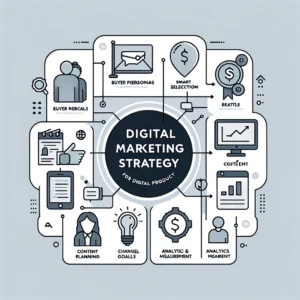In the world of software product development, staying ahead of the competition is not just a goal—it’s a necessity. Competitive analysis, a critical tool in a developer’s arsenal, plays a pivotal role in shaping strategies, guiding product development, and ensuring market relevance. But what exactly does competitive analysis entail in this context, and why is it so crucial for software developers, especially in a market brimming with innovation and competition?

At its core, competitive analysis in software product development involves a thorough examination of competing products, market trends, and consumer preferences. It’s a process that extends beyond mere observation; it’s about understanding the strengths and weaknesses of competitors to inform strategic decisions. This guide is designed to walk you through the nuances of competitive analysis, providing insights into its components, strategies, and how it can be leveraged to drive success in software product development. For professionals with a medium level of knowledge in this field, this article will deepen your understanding and equip you with practical tools and strategies to elevate your competitive analysis skills.
Understanding Competitive Analysis in Software Product Development
In the intricate and ever-changing landscape of software product development, competitive analysis emerges as a beacon, guiding companies through the tumultuous seas of market competition and technological evolution. This in-depth exploration of competitive analysis will illuminate its multifaceted role, the profound insights it offers, and how it shapes the trajectory of product development in the software industry.
Looking for advice in product development?
What is Competitive Analysis?
At its essence, competitive analysis in software product development is a strategic undertaking that goes beyond mere identification of rivals. It is an analytical process aimed at dissecting and understanding the strategies, products, and market presence of competitors. This scrutiny extends to a broad spectrum of areas, including but not limited to, product features, user experience, pricing strategies, marketing tactics, and customer feedback.
The objective is multifaceted: to gauge where your product stands in the competitive landscape, to identify areas of opportunity and improvement, and to predict future market trends. This comprehensive understanding is crucial in crafting strategies that not only counteract competitors’ moves but also place your product in a position of advantage.
Role in Software Development

In the realm of software development, competitive analysis assumes a pivotal role. It’s not simply about being aware of what others are doing; it’s about proactive strategizing and informed decision-making. In an industry driven by innovation and rapid technological advancements, understanding the competitive environment is key to survival and success.
Through competitive analysis, software developers gain valuable insights into what features are resonating with users, what gaps exist in the market, and what new technologies or methodologies are emerging. This knowledge is instrumental in several facets of software development:
- Feature Development and Enhancement: By analyzing competing products, developers can identify which features are most desired by users, what’s lacking in the market, and how they can innovate to meet those unmet needs.
- Market Positioning: Understanding how competitors position themselves in the market helps in carving out a unique niche or value proposition for your product. It’s about differentiating your product in a way that speaks directly to the needs and preferences of your target audience.
- Predictive Planning: The software industry is known for its rapid pace and constant change. Competitive analysis aids in anticipating market trends and technological shifts, allowing developers to plan and adapt accordingly.
- Risk Management: By understanding the strengths and weaknesses of competitors, developers can foresee potential challenges and mitigate risks associated with product development and market entry.
- Strategic Marketing: Insights from competitive analysis inform marketing strategies, ensuring that communication and promotional efforts are tailored to highlight the unique benefits and features of your product, distinguishing it from competitors.
In essence, competitive analysis in software product development is not a mere tactical move but a strategic imperative. It empowers developers and companies to make informed decisions, innovate with purpose, and navigate the market with a clearer vision.
As we delve deeper into the components and strategies of effective competitive analysis, it becomes increasingly evident how integral it is to the success of software products. In the following sections, we will explore these elements in greater detail, providing you with the knowledge and tools to conduct comprehensive and impactful competitive analysis.
Key Components of Effective Competitive Analysis
Delving into the key components of effective competitive analysis reveals a systematic approach that can significantly impact the development and success of software products. This segment of our guide explores the essential elements that constitute a robust competitive analysis framework, essential for any software development team aiming to carve a niche in the market.
Identifying Competitors
The foundation of any competitive analysis lies in the accurate identification of competitors. This task goes beyond surface-level knowledge, requiring a deep dive into the software market to understand who your direct and indirect competitors are. Direct competitors are those offering similar products or services targeting the same customer base, while indirect competitors might cater to different segments but still overlap with some aspects of your product.
Identifying competitors involves several steps:
- Market research to understand the current landscape.
- Customer surveys to gauge awareness and perceptions of competing products.
- Monitoring industry reports and publications for emerging players.
Once identified, categorizing competitors based on various parameters like market share, product features, target demographics, and business models can provide a clearer picture of the competitive landscape.
Analyzing Competitor Products
After identifying competitors, the next critical step is an in-depth analysis of their products. This analysis should cover a broad spectrum of elements such as:
- Features and functionalities: What features do these products offer, and how do they align with customer needs?
- User experience and design: How user-friendly and aesthetically appealing are these products?
- Performance and reliability: Assessing the overall performance, speed, and reliability of these products.
- Pricing and value proposition: Understanding the pricing strategy and how it correlates with the product’s value proposition.
- Customer feedback and reviews: Analyzing what users are saying about these products, their satisfaction level, and their pain points.
This thorough product analysis helps in benchmarking your product against competitors and identifying areas for improvement or innovation.
Market Positioning and Target Audience
Understanding the market positioning and target audience of your competitors is another crucial aspect. This involves analyzing how competitors are positioning their products in the market and the messaging they use to attract their target audience. Key questions to consider include:
- What market needs are they addressing?
- What is their brand messaging and how do they differentiate themselves?
- Who is their primary target audience, and how do they engage with them?
This information is vital in crafting your unique selling proposition (USP) and developing marketing strategies that resonate with your intended audience.
Technology and Innovation Trends
In the fast-paced software industry, staying abreast of technology and innovation trends is paramount. Competitive analysis in this aspect involves:
- Monitoring technological advancements in the industry.
- Understanding how competitors are integrating new technologies into their products.
- Identifying emerging trends that could disrupt the current market dynamics.
This knowledge not only helps in keeping your product technologically relevant but also in anticipating future market demands and positioning your product to meet those needs.
In summary, the key components of effective competitive analysis in software product development – identifying competitors, analyzing their products, understanding market positioning, and staying updated on technology trends – are critical in developing a product that stands out in the competitive marketplace. Armed with this understanding, developers and companies can craft strategies that not only meet current market demands but also anticipate future trends and shifts.
Strategies for Conducting Comprehensive Competitive Analysis
In the arena of software product development, conducting a comprehensive competitive analysis requires a strategic blend of methodologies and tools. This segment focuses on the key strategies that can be employed to ensure a thorough and effective analysis, providing invaluable insights for decision-making and strategy formulation.
Utilizing SWOT Analysis
A SWOT (Strengths, Weaknesses, Opportunities, Threats) Analysis is a foundational tool in competitive analysis. This strategic framework helps in assessing both your product and your competitors’ from four critical angles. Here’s how it can be applied:
- Strengths: Identify what your product does best, its unique features, and what sets it apart from the competition. Likewise, analyze the strengths of your competitors’ products. This could include superior technology, brand recognition, customer loyalty, or innovative features.
- Weaknesses: Understanding the weaknesses of both your product and your competitors’ is crucial. This might include lacking features, limitations in technology, pricing strategy flaws, or gaps in customer service.
- Opportunities: Here, you look for external factors that could be advantageous. This could be an emerging market trend, a gap in competitors’ offerings, or technological advancements you can leverage.
- Threats: Identifying potential threats is crucial for risk management. This includes new competitors entering the market, changes in customer preferences, or new regulations affecting your product.
Conducting a SWOT analysis provides a balanced perspective, enabling you to strategize effectively and position your product for success.
Implementing Porter’s Five Forces Model
Porter’s Five Forces Model is another strategic analytical tool, especially useful for understanding the competitive forces in your industry. The five forces include:
- Competitive Rivalry: How intense is the competition in your industry, and what are the implications for your product?
- Supplier Power: Analyze the power of suppliers in your industry. How easy is it for suppliers to drive up prices? This can affect your production costs and profitability.
- Buyer Power: How easy is it for buyers to drive prices down? If you have many competitors, buyers have more choices and thus more power.
- Threat of Substitution: Assess the likelihood of customers finding a different way of doing what your product does.
- Threat of New Entry: How easy is it for new competitors to enter your market? High barriers to entry can protect your market position.
The Importance of Continuous Monitoring
Competitive landscapes in the software industry are dynamic. Continuous monitoring of competitors and market trends is essential for maintaining a competitive edge. This involves:
- Regularly updating your competitive analysis to reflect market changes.
- Keeping track of competitors’ new product releases, updates, or strategic moves.
- Monitoring customer feedback and reviews for both your product and competitors’.
- Staying informed about industry news, reports, and market research.
In summary, implementing these strategies – SWOT analysis, Porter’s Five Forces, and continuous monitoring – equips software developers and companies with a comprehensive understanding of their competitive environment. This understanding is pivotal in making informed decisions, anticipating market shifts, and ensuring the long-term success of your software product.
Leveraging Competitive Analysis Insights
Harnessing the power of competitive analysis insights is fundamental in shaping the future of software products. This part of the guide delves into how the insights gleaned from a thorough competitive analysis can be strategically applied to enhance product development, improve user experience, and adapt to market changes.
Informing Product Development Decisions
The insights from competitive analysis play a pivotal role in product development decisions. This process involves:
- Feature Prioritization: Understanding which features are most valued by users and how competitors’ features are received can guide the prioritization of your product development efforts.
- Identifying Market Gaps: Competitive analysis can reveal unmet needs or gaps in the market, presenting opportunities for your product to fill these voids.
- Benchmarking: Use competitor products as benchmarks to set standards for your product in terms of quality, functionality, and user experience.
- Innovative Thinking: Insights from competitive analysis can inspire innovative ideas, encouraging your team to think outside the box and develop unique solutions.
Enhancing Product Features and User Experience
The end goal of any software product is to provide a seamless, efficient, and enjoyable user experience. Competitive analysis can significantly contribute to this by:
- User Experience (UX) Analysis: Evaluating the UX of competitor products can offer insights into user preferences, pain points, and expectations.
- Feature Improvement: Insights from competitive analysis can inform enhancements to existing features or the development of new ones.
- Design Optimization: Analyzing competitor designs can inspire improvements in the visual appeal and usability of your product.
Predicting and Reacting to Market Changes
In a rapidly evolving industry, the ability to predict and adapt to market changes is crucial. Competitive analysis aids in this by:
- Trend Analysis: Understanding market trends and how competitors are responding sets the stage for predicting future market shifts.
- Agile Response: Insights from competitive analysis enable a more agile response to market changes, whether it’s adapting to new customer needs or technological advancements.
- Strategic Planning: Long-term strategic planning can be informed by trends and patterns identified through competitive analysis, helping to future-proof your product.
In essence, leveraging the insights from competitive analysis is about transforming data into actionable strategies. It’s a process that influences every aspect of software product development, from conceptualization to market launch and beyond. By applying these insights, companies can ensure their products are not only competitive but also aligned with market needs and future trends.
Case Studies and Real-world Examples (Expanded with Real-Life Examples)
To deepen our understanding of competitive analysis in software product development, let’s look at real-life examples that illustrate both successful applications and cautionary tales.
Real-Life Success Story: Spotify
Spotify’s Market Entry and Growth Strategy: When Spotify entered the music streaming market, it faced stiff competition from established players like Apple Music and Pandora. Through meticulous competitive analysis, Spotify identified gaps in user experience and content curation. They focused on personalized playlists, easy-to-use interfaces, and social sharing features, aspects that were not as strongly emphasized by their competitors at the time. This strategic move, informed by competitive analysis, allowed Spotify to carve out a unique position in the market and attract a broad user base.
Learning from Failure: BlackBerry’s Decline
BlackBerry’s Missed Opportunities: BlackBerry, once a leader in the smartphone market, failed to keep pace with competitors like Apple and Samsung. BlackBerry underestimated the importance of consumer-focused features and the emerging app ecosystem, elements that were heavily capitalized on by its competitors. This lack of insight, a failure in effectively conducting competitive analysis, led to the company’s significant decline in the smartphone market.
Adapting to Market Changes: Adobe’s Shift to Subscription Model
Adobe’s Strategic Pivot: Adobe, known for its Creative Suite of software products, faced the challenge of software piracy and a rapidly changing digital landscape. By conducting competitive analysis and understanding market trends, Adobe shifted from a traditional software sales model to a cloud-based subscription service. This move, a direct response to the evolving market and competitor strategies, revitalized Adobe’s business model and led to sustained growth.
These real-life examples demonstrate the critical role of competitive analysis in software product development. Spotify’s success story shows the power of identifying and capitalizing on market gaps, while BlackBerry’s decline serves as a cautionary tale about underestimating market shifts and competitor innovations. Adobe’s strategic pivot illustrates the importance of adapting to industry changes and evolving consumer preferences.
By studying these examples, software developers and companies can gain valuable insights into the practical application of competitive analysis, learning how to navigate the competitive landscape strategically and make informed decisions that drive success.
Conclusion
Competitive analysis in software product development is not merely a component of market research; it is a strategic imperative that shapes the course of product development, marketing, and long-term business success. Throughout this comprehensive guide, we have explored the multifaceted nature of competitive analysis, its critical components, strategic implementation, and the profound impact it can have when correctly applied.
Recap of Key Points
- Understanding Competitive Analysis: We began by defining competitive analysis in the context of software product development, emphasizing its role in understanding the competitive landscape, guiding strategic decisions, and informing product development.
- Key Components: Identifying competitors, analyzing their products, understanding market positioning, and staying abreast of technology trends are foundational in conducting effective competitive analysis.
- Strategic Implementation: Employing tools like SWOT analysis and Porter’s Five Forces, coupled with continuous monitoring, provides a comprehensive understanding of the competitive environment.
- Leveraging Insights: The insights gleaned from competitive analysis are instrumental in enhancing product features, improving user experience, and strategically adapting to market changes.
- Real-world Examples: Through real-life case studies like Spotify, BlackBerry, and Adobe, we illustrated the practical application of competitive analysis, highlighting both success stories and cautionary tales.
The Strategic Value of Competitive Analysis
In conclusion, competitive analysis is a critical tool for any software development company looking to thrive in a competitive market. It offers a roadmap for navigating market complexities, understanding customer needs, and outmaneuvering competitors. By diligently applying the principles and strategies outlined in this guide, companies can not only anticipate and adapt to market dynamics but also innovate and lead in their respective domains.
Competitive analysis, when executed effectively, transforms data and insights into strategic actions, propelling software products to new heights of success and relevance. It’s a process that demands ongoing attention and adaptation, but the rewards – a robust, market-leading software product – are well worth the effort.



